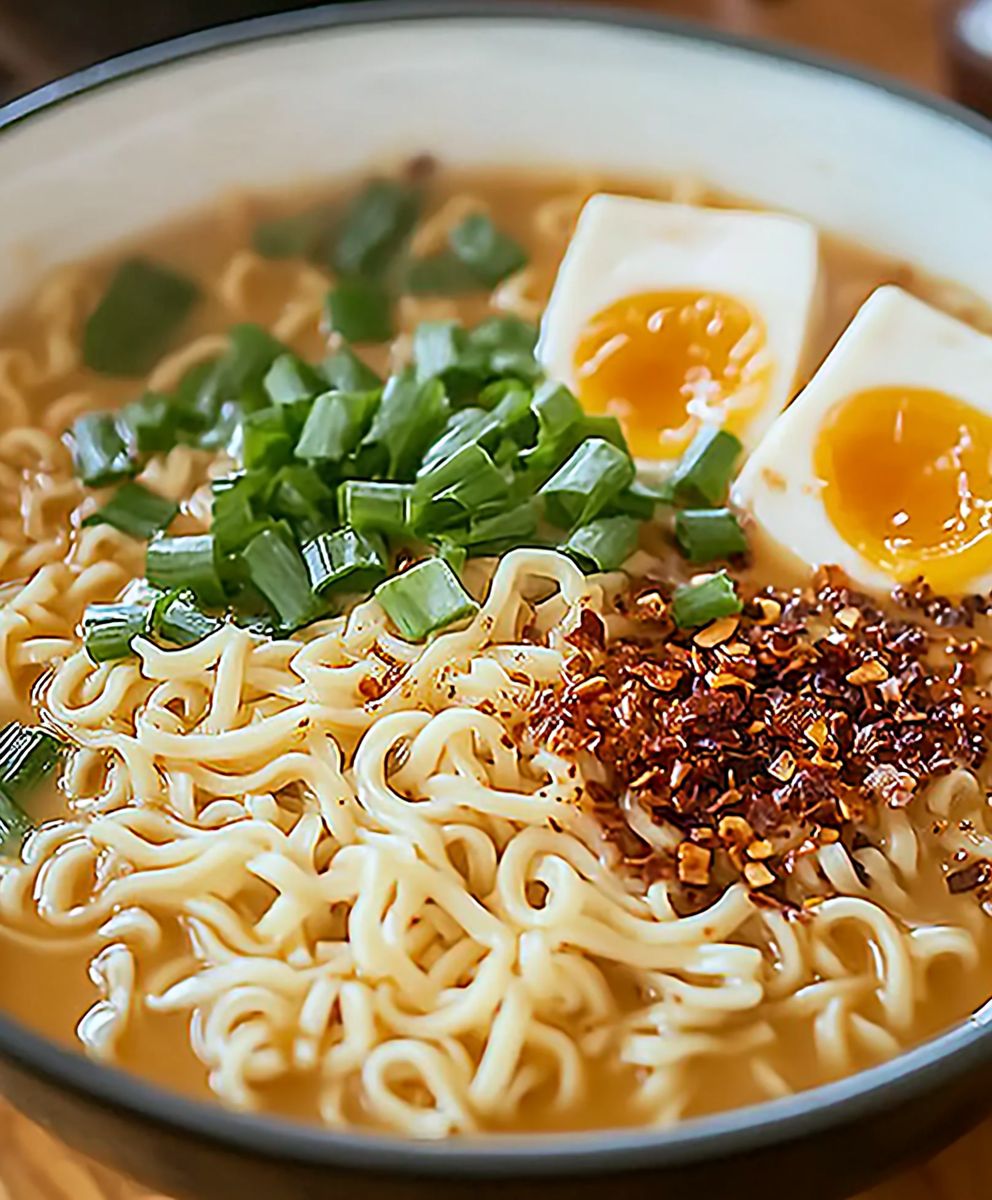Ramen noodle soup, a culinary masterpiece that transcends borders and generations, is more than just a quick meal; it’s an experience. Imagine a steaming bowl of rich, savory broth, perfectly cooked noodles with just the right amount of chew, and an array of toppings that tantalize the taste buds. Are you ready to embark on a flavorful journey that will warm your soul and leave you craving more?
Originating in China and later popularized in Japan, ramen noodle soup has evolved into a global phenomenon. Each region boasts its unique take on this beloved dish, from the creamy tonkotsu of Kyushu to the miso ramen of Hokkaido. But regardless of the variation, the essence remains the same: a comforting and satisfying bowl of noodles that brings people together.
What is it about ramen that captivates so many? Perhaps it’s the umami-rich broth, simmered for hours to extract maximum flavor. Or maybe it’s the satisfying slurp of perfectly cooked noodles, each strand coated in that delicious broth. For many, it’s the convenience and versatility of ramen, a customizable dish that can be tailored to individual preferences. Whether you’re a seasoned ramen aficionado or a curious newcomer, prepare to be amazed by the depth and complexity of this iconic dish. Let’s dive in and discover the secrets to creating the perfect bowl of ramen at home!
Ingredients:
- For the Broth:
- 8 cups chicken broth (low sodium preferred)
- 2 cups water
- 4 oz pork belly, thinly sliced (optional, but highly recommended!)
- 4 cloves garlic, minced
- 1 inch ginger, peeled and grated
- 2 green onions, white parts only, thinly sliced
- 1/4 cup soy sauce
- 2 tablespoons mirin
- 1 tablespoon sake (optional)
- 1 teaspoon sesame oil
- 1 sheet kombu (dried kelp), about 4×4 inches
- 1/2 teaspoon white pepper
- For the Noodles:
- 4 packages ramen noodles (dried or fresh, depending on preference)
- For the Toppings:
- 4 soft-boiled eggs, peeled and halved
- 4 green onions, green parts only, thinly sliced
- 1 cup cooked bamboo shoots (menma)
- 1 cup wood ear mushrooms, rehydrated and sliced
- 1/2 cup nori seaweed, cut into strips
- 1/2 cup corn kernels (fresh or frozen)
- Chili oil or sriracha (optional, for spice)
- Sesame seeds (optional, for garnish)
- Spinach or other leafy greens (optional)
Preparing the Broth:
- Infuse the Broth: In a large pot or Dutch oven, combine the chicken broth, water, pork belly (if using), garlic, ginger, and white parts of the green onions. Add the kombu sheet. Bring the mixture to a simmer over medium heat.
- Simmer and Skim: Reduce the heat to low and let the broth simmer gently for at least 30 minutes, or up to 1 hour. The longer it simmers, the more flavorful it will become. As it simmers, skim off any foam or impurities that rise to the surface using a fine-mesh skimmer or spoon. This will help create a clearer and cleaner-tasting broth.
- Strain the Broth: After simmering, remove the kombu sheet. You can discard it or save it for another use (like making dashi). Strain the broth through a fine-mesh sieve lined with cheesecloth (if desired) to remove the solids. This will result in a smoother broth. Discard the solids.
- Season the Broth: Return the strained broth to the pot. Add the soy sauce, mirin, sake (if using), and sesame oil. Stir well to combine. Taste the broth and adjust the seasoning as needed. You may want to add a pinch of salt or more soy sauce to achieve your desired level of saltiness. Add the white pepper.
- Keep Warm: Keep the broth warm over low heat while you prepare the noodles and toppings.
Preparing the Toppings:
- Prepare the Eggs: If you haven’t already, prepare the soft-boiled eggs. Bring a pot of water to a boil. Gently lower the eggs into the boiling water and cook for 6-7 minutes for a perfectly soft-boiled yolk. Immediately transfer the eggs to an ice bath to stop the cooking process. Once cooled, peel the eggs carefully and halve them lengthwise.
- Prepare the Bamboo Shoots: If using canned bamboo shoots, drain them and rinse them under cold water. Slice them thinly. You can quickly sauté them in a pan with a little sesame oil for added flavor, but this is optional.
- Prepare the Wood Ear Mushrooms: If using dried wood ear mushrooms, rehydrate them by soaking them in warm water for about 30 minutes, or until they are soft and pliable. Drain the mushrooms and slice them thinly.
- Prepare the Green Onions: Thinly slice the green parts of the green onions.
- Prepare the Nori Seaweed: Cut the nori seaweed sheets into thin strips using scissors or a sharp knife.
- Prepare the Corn: If using frozen corn, thaw it before using. If using fresh corn, you can grill it or boil it briefly before cutting the kernels off the cob.
- Prepare the Spinach (Optional): If using spinach, wash it thoroughly and blanch it briefly in boiling water for about 30 seconds. Drain it and squeeze out any excess water.
Cooking the Noodles:
- Cook the Noodles: Bring a large pot of water to a rolling boil. Add the ramen noodles and cook according to the package directions. Fresh ramen noodles typically cook faster than dried noodles, so be sure to check them frequently.
- Drain the Noodles: Once the noodles are cooked al dente (slightly firm to the bite), drain them immediately in a colander. Do not overcook the noodles, as they will continue to cook slightly in the hot broth.
- Rinse (Optional): Some people prefer to rinse the noodles briefly under cold water to remove excess starch. This can help prevent them from sticking together. However, rinsing the noodles can also cool them down, so it’s a matter of personal preference.
Assembling the Ramen:
- Warm the Bowls: This step is optional but recommended. Warming the bowls helps keep the ramen hot for longer. You can warm the bowls by filling them with hot water for a few minutes and then emptying them.
- Add the Noodles: Divide the cooked ramen noodles evenly among the warmed bowls.
- Ladle the Broth: Ladle the hot broth over the noodles, making sure to submerge them completely.
- Arrange the Toppings: Arrange the toppings artfully on top of the noodles and broth. This is where you can get creative and customize your ramen to your liking. Place the halved soft-boiled egg, sliced green onions, bamboo shoots, wood ear mushrooms, nori seaweed strips, and corn kernels on top. You can also add a few slices of pork belly if you used it in the broth.
- Add Optional Garnishes: Drizzle a little chili oil or sriracha over the ramen for a spicy kick (if desired). Sprinkle sesame seeds over the top for added flavor and visual appeal.
- Serve Immediately: Serve the ramen immediately while it’s hot and the noodles are still al dente. Enjoy!
Tips and Variations:
- Broth Variations: Experiment with different types of broth. You can use vegetable broth for a vegetarian option, or try adding miso paste for a miso ramen. You can also add a splash of fish sauce for extra umami.
- Noodle Variations: Use different types of noodles. Udon noodles or soba noodles can be used as a substitute for ramen noodles.
- Protein Variations: Add different types of protein. Grilled chicken, shrimp, tofu, or even leftover roast beef can be added to ramen.
- Vegetable Variations: Add different types of vegetables. Bean sprouts, bok choy, mushrooms, or carrots can be added to ramen.
- Spice Level: Adjust the spice level to your liking. Add more or less chili oil or sriracha, or use a different type of chili paste.
- Make it Ahead: The broth can be made ahead of time and stored in the refrigerator for up to 3 days. The toppings can also be prepared ahead of time. Cook the noodles just before serving to prevent them from becoming soggy.
- Egg Perfection: Achieving the perfect soft-boiled egg can be tricky. Experiment with different cooking times to find your sweet spot. Some people prefer a runnier yolk, while others prefer a slightly firmer yolk.
- Kombu Usage: Don’t discard the kombu after using it in the broth! You can slice it thinly and add it to the ramen as a topping, or use it to make other dishes like simmered vegetables.
- Pork Belly Preparation: If you’re using pork belly, you can also braise it separately for a richer flavor. Braise it in soy sauce, mirin, sake, and sugar until it’s tender and flavorful. Then, slice it thinly and add it to the ramen.

Conclusion:
This isn’t just another ramen recipe; it’s a gateway to cozy nights and flavor explosions! I truly believe this ramen noodle soup is a must-try for anyone craving a comforting, customizable, and utterly delicious meal. From the rich, savory broth to the perfectly cooked noodles and the endless possibilities for toppings, this recipe offers a complete culinary experience that’s surprisingly easy to achieve at home.
Why is it a must-try? Because it’s more than just a quick meal; it’s an opportunity to create something special. It’s a chance to experiment with flavors, textures, and ingredients to craft a bowl of ramen that perfectly suits your taste. It’s also incredibly satisfying to make something so delicious from scratch, knowing exactly what went into it. Forget those instant noodles this is the real deal!
But the best part? The versatility! While I’ve outlined my favorite combination of ingredients, the beauty of this recipe lies in its adaptability. Feeling adventurous? Try adding a dollop of chili oil for a spicy kick. Craving something richer? A swirl of sesame oil will do the trick. Vegetarian? Swap the chicken broth for vegetable broth and load up on tofu and mushrooms. The possibilities are truly endless!
Serving Suggestions and Variations:
* Egg-cellent Additions: A soft-boiled egg is a classic ramen topping, but don’t be afraid to experiment! Try a marinated egg (ajitsuke tamago) for an extra layer of flavor.
* Meat Lovers’ Paradise: While I used sliced pork belly, you could easily substitute it with grilled chicken, shredded beef, or even crispy tofu for a vegetarian option.
* Veggie Power: Load up on your favorite vegetables! Spinach, bok choy, bean sprouts, corn, and scallions are all fantastic additions.
* Spice It Up: A dash of sriracha, a sprinkle of chili flakes, or a spoonful of gochujang will add a fiery kick to your ramen.
* Noodle Nirvana: While I recommend fresh ramen noodles, you can also use dried ramen noodles or even udon noodles for a different texture.
* Broth Boosters: Enhance the broth with a splash of soy sauce, a drizzle of mirin, or a knob of ginger for added depth of flavor.
* Garnish Galore: Don’t forget the garnishes! Sesame seeds, nori seaweed, and chopped scallions are all essential for adding visual appeal and flavor.
I’m so excited for you to try this recipe and experience the joy of homemade ramen. It’s a dish that’s perfect for a cozy night in, a quick weeknight meal, or even a fun weekend project. I promise, once you taste the difference between homemade and store-bought ramen, you’ll never go back!
So, what are you waiting for? Gather your ingredients, put on your apron, and get ready to create a bowl of ramen noodle soup that will tantalize your taste buds and warm your soul. And most importantly, don’t forget to share your creations with me! I’d love to see your variations and hear about your experience. Tag me in your photos on social media and let me know what you think. Happy cooking! I can’t wait to see your ramen masterpieces!
Ramen Noodle Soup: The Ultimate Guide to Delicious Homemade Ramen
Flavorful, customizable homemade ramen with rich broth, tender noodles, soft-boiled egg, and various toppings.
Ingredients
- 8 cups chicken broth (low sodium preferred)
- 2 cups water
- 4 oz pork belly, thinly sliced (optional, but highly recommended!)
- 4 cloves garlic, minced
- 1 inch ginger, peeled and grated
- 2 green onions, white parts only, thinly sliced
- 1/4 cup soy sauce
- 2 tablespoons mirin
- 1 tablespoon sake (optional)
- 1 teaspoon sesame oil
- 1 sheet kombu (dried kelp), about 4×4 inches
- 1/2 teaspoon white pepper
- 4 packages ramen noodles (dried or fresh, depending on preference)
- 4 soft-boiled eggs, peeled and halved
- 4 green onions, green parts only, thinly sliced
- 1 cup cooked bamboo shoots (menma)
- 1 cup wood ear mushrooms, rehydrated and sliced
- 1/2 cup nori seaweed, cut into strips
- 1/2 cup corn kernels (fresh or frozen)
- Chili oil or sriracha (optional, for spice)
- Sesame seeds (optional, for garnish)
- Spinach or other leafy greens (optional)
Instructions
- Infuse the Broth: In a large pot or Dutch oven, combine the chicken broth, water, pork belly (if using), garlic, ginger, and white parts of the green onions. Add the kombu sheet. Bring the mixture to a simmer over medium heat.
- Simmer and Skim: Reduce the heat to low and let the broth simmer gently for at least 30 minutes, or up to 1 hour. The longer it simmers, the more flavorful it will become. As it simmers, skim off any foam or impurities that rise to the surface using a fine-mesh skimmer or spoon. This will help create a clearer and cleaner-tasting broth.
- Strain the Broth: After simmering, remove the kombu sheet. You can discard it or save it for another use (like making dashi). Strain the broth through a fine-mesh sieve lined with cheesecloth (if desired) to remove the solids. This will result in a smoother broth. Discard the solids.
- Season the Broth: Return the strained broth to the pot. Add the soy sauce, mirin, sake (if using), and sesame oil. Stir well to combine. Taste the broth and adjust the seasoning as needed. You may want to add a pinch of salt or more soy sauce to achieve your desired level of saltiness. Add the white pepper.
- Keep Warm: Keep the broth warm over low heat while you prepare the noodles and toppings.
- Prepare the Eggs: If you haven’t already, prepare the soft-boiled eggs. Bring a pot of water to a boil. Gently lower the eggs into the boiling water and cook for 6-7 minutes for a perfectly soft-boiled yolk. Immediately transfer the eggs to an ice bath to stop the cooking process. Once cooled, peel the eggs carefully and halve them lengthwise.
- Prepare the Bamboo Shoots: If using canned bamboo shoots, drain them and rinse them under cold water. Slice them thinly. You can quickly sauté them in a pan with a little sesame oil for added flavor, but this is optional.
- Prepare the Wood Ear Mushrooms: If using dried wood ear mushrooms, rehydrate them by soaking them in warm water for about 30 minutes, or until they are soft and pliable. Drain the mushrooms and slice them thinly.
- Prepare the Green Onions: Thinly slice the green parts of the green onions.
- Prepare the Nori Seaweed: Cut the nori seaweed sheets into thin strips using scissors or a sharp knife.
- Prepare the Corn: If using frozen corn, thaw it before using. If using fresh corn, you can grill it or boil it briefly before cutting the kernels off the cob.
- Prepare the Spinach (Optional): If using spinach, wash it thoroughly and blanch it briefly in boiling water for about 30 seconds. Drain it and squeeze out any excess water.
- Cook the Noodles: Bring a large pot of water to a rolling boil. Add the ramen noodles and cook according to the package directions. Fresh ramen noodles typically cook faster than dried noodles, so be sure to check them frequently.
- Drain the Noodles: Once the noodles are cooked al dente (slightly firm to the bite), drain them immediately in a colander. Do not overcook the noodles, as they will continue to cook slightly in the hot broth.
- Rinse (Optional): Some people prefer to rinse the noodles briefly under cold water to remove excess starch. This can help prevent them from sticking together. However, rinsing the noodles can also cool them down, so it’s a matter of personal preference.
- Warm the Bowls: This step is optional but recommended. Warming the bowls helps keep the ramen hot for longer. You can warm the bowls by filling them with hot water for a few minutes and then emptying them.
- Add the Noodles: Divide the cooked ramen noodles evenly among the warmed bowls.
- Ladle the Broth: Ladle the hot broth over the noodles, making sure to submerge them completely.
- Arrange the Toppings: Arrange the toppings artfully on top of the noodles and broth. This is where you can get creative and customize your ramen to your liking. Place the halved soft-boiled egg, sliced green onions, bamboo shoots, wood ear mushrooms, nori seaweed strips, and corn kernels on top. You can also add a few slices of pork belly if you used it in the broth.
- Add Optional Garnishes: Drizzle a little chili oil or sriracha over the ramen for a spicy kick (if desired). Sprinkle sesame seeds over the top for added flavor and visual appeal.
- Serve Immediately: Serve the ramen immediately while it’s hot and the noodles are still al dente. Enjoy!
Notes
- Broth Variations: Experiment with different types of broth. You can use vegetable broth for a vegetarian option, or try adding miso paste for a miso ramen. You can also add a splash of fish sauce for extra umami.
- Noodle Variations: Use different types of noodles. Udon noodles or soba noodles can be used as a substitute for ramen noodles.
- Protein Variations: Add different types of protein. Grilled chicken, shrimp, tofu, or even leftover roast beef can be added to ramen.
- Vegetable Variations: Add different types of vegetables. Bean sprouts, bok choy, mushrooms, or carrots can be added to ramen.
- Spice Level: Adjust the spice level to your liking. Add more or less chili oil or sriracha, or use a different type of chili paste.
- Make it Ahead: The broth can be made ahead of time and stored in the refrigerator for up to 3 days. The toppings can also be prepared ahead of time. Cook the noodles just before serving to prevent them from becoming soggy.
- Egg Perfection: Achieving the perfect soft-boiled egg can be tricky. Experiment with different cooking times to find your sweet spot. Some people prefer a runnier yolk, while others prefer a slightly firmer yolk.
- Kombu Usage: Don’t discard the kombu after using it in the broth! You can slice it thinly and add it to the ramen as a topping, or use it to make other dishes like simmered vegetables.
- Pork Belly Preparation: If you’re using pork belly, you can also braise it separately for a richer flavor. Braise it in soy sauce, mirin, sake, and sugar until it’s tender and flavorful. Then, slice it thinly and add it to the ramen.





Leave a Comment